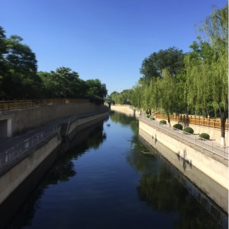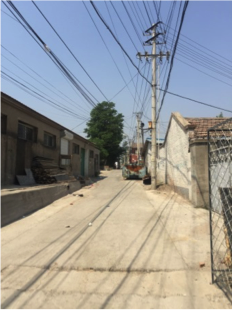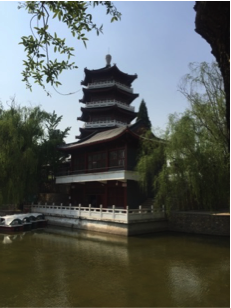Beijing’s green infrastructure – addressing climate change in a rapidly urbanising megacity
Wei Zheng and Cecilia Wong
This is the second in a series of three blogs by the research team of the Eco-Urbanisation: Promoting Sustainable Development in Metropolitan Regions in China, describing the opportunities offered by green infrastructure in supporting Beijing’s adaptation to climate change.

Green infrastructure (GI) is widely regarded as a cutting-edge management approach to address the challenge of climate change. With policy agendas emphasising climate mitigation and adaptation, it is important to explore the various benefits delivered by GI to both the urban and urban-fringe landscapes to help realise the objectives of moving towards an ecologically-oriented urbanisation model. GI is also closely resonant to a traditional Chinese cultural practice of ‘fengshui’ which links the subject with the surrounding environment.
Beijing, the capital city of China, has excellent ‘fengshui’ as it is surrounded by gorgeous mountains (the Taihang to the west and the Yanshan to the east) and large water bodies. While the city of Beijing is well endowed with green infrastructure, it is important to ask what types of ‘green’ infrastructure exist in the ‘urban’ and ‘urban fringe’ area of the Beijing metropolitan region. Our recent fieldwork in 22 local communities in Beijing offers some insights into this question.
In the city centre, the main types of green infrastructure are parks, roadside greenways, and attached green space in residential/commercial land. Roadside greenways are distributed along the main roads of the city centre. In residential communities, however, the conditions of GI vary widely in terms of the density, maintenance and aesthetics. Whatever the local environment of the community is, community parks are evident in the central area of Beijing, as shown by Google Maps.
There are quite a lot of low-rise apartment communities in the Beijing metropolitan region, mostly with buildings of five to six floors. The basic GI profiles of these communities are rather similar: with trees, shrubs, grass and flowers as the main vegetation. Trees and shrubs are closely growing together and between buildings, though the density varies across different communities. Bird songs and calls are not a rarity in these low-rise apartment communities. One common design of this type of community is the presence of some communal open space with exercise equipment.

‘Urban villages’ are another interesting phenomenon in Chinese cities. These always appear on the outskirts and the downtown segments of major Chinese cities as a result of the enclosure of rural land by rapid urbanisation. We went to three urban villages during the fieldtrip to Beijing. Although the village profiles are quite similar, one thing is certain – it is not easy to discover the ‘green’ and only a few trees are scattered sporadically.
Despite the fact that Beijing has been experiencing rapid urbanisation, one can still find some rural townships in the periphery of the city. It is interesting to find such small towns existing in their original, natural form, as many single story residential buildings have vegetation such as trees and vegetable patch in the front yard. The tranquillity of these rural areas are characterised by few motor vehicles and limited public facilities. In a visit to the township of Xiji (西集镇), the authors went to Huzhuang village (胡庄村). It was great to find working farmland in the village, another GI, including agricultural land, woodlands and orchards. One attractive GI of the village is a cherry-picking garden near the village which has stimulated its own eco-tourism. Of course, in the village area, one cannot find any parks despite this being a common form of GI in urban areas.

GI, in conjunction with other forms of infrastructure, is an indispensable part of a city’s growth and development. Urbanisation has drastically altered the landscape and environmental profile of a city and its wider hinterland. Our fieldtrip has confirmed that rather than having a simple, monochrome GI profile, various green landscapes and types – ranging from more planned GI in urban core to small scale vegetable patches and gardens in the urban-rural fringes – are found across different communities in the Beijing city-region. In order to tackle climate change and promote ecological well-being in communities, there is a need to effectively grasp the relationship between different types and profile of GI and their interaction with the urbanisation process, as well as identifying the benefits and impacts brought about by such interactions to the ecological system.
Wei Zheng and Cecilia Wong Principal Investigator) both work on the ESRC funded project, Eco-Urbanisation: Promoting Sustainable Development in Metropolitan Regions of China.